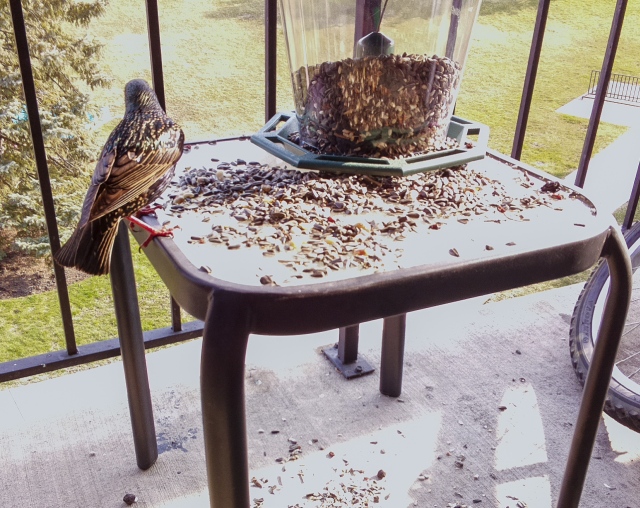This page contains all of the species that have been captured on the feedercam, in the order of newest to old. Pictures are from the camera unless otherwise stated. Each species name is linked to the species profile at the Cornell Lab of Ornithology’s All About Birds site – one of my go-to sources for bird identification and info!

European Starling – Sturnus vulgaris
This is an invasive species brought to the United States in the nineteenth century by fans of William Shakespeare. These fans wanted all of the birds mentioned in Shakespeare’s writings to be found in the US – a poetic goal, but a major problem for our native species. Starlings are found throughout North America, and are very common in cities and towns. They often move in flocks, and can be very noisy. You will have little-to-no trouble finding this species.
House Sparrow – Passer domesticus
This species was introduced to the United States in 1851, and has since spread throughout the majority of the contiguous states and into Central America. It is considered an invasive, and nuisance species, as they tend to bully native species. They do exhibit sexual dimorphism, with females having duller brown feathers with streaks of black, and males having darker brown feathers, streaked with black, white cheeks, gray crowns, and a black bib. They are a very common feeder bird, and tend to show up in flocks.
Northern Cardinal – Cardinalis cardinalis
Found throughout most of central and all of the eastern United States, this species is one of the most recognizable species in its range. This species is the state bird of seven states in the US, one of which is my home state of Illinois. Males are a vibrant red, while females are a dusty brown with red accents. Both sexes have bright orange bills and sharp crests. Cardinals are common feeder birds, and often found backyards.
House Finch – Haemorhous mexicanus
This is technically an introduced species to the United States, though it can now be found throughout most of the country. They are extremely common at bird feeders, and will often be found in pairs of groups. Males have a red head an chest, while females are plain brown with a striped chest. As birds cannot make bright red or yellow pigments, male house finches get their red color from the food they eat. Females prefer males with redder chests.
